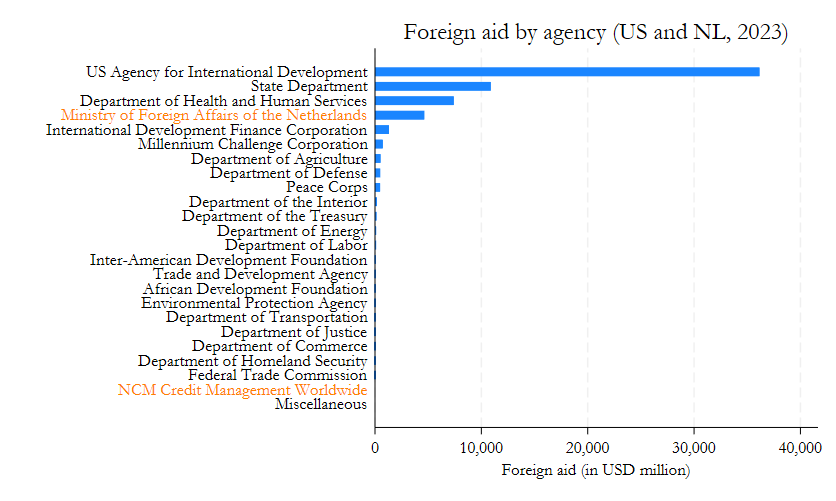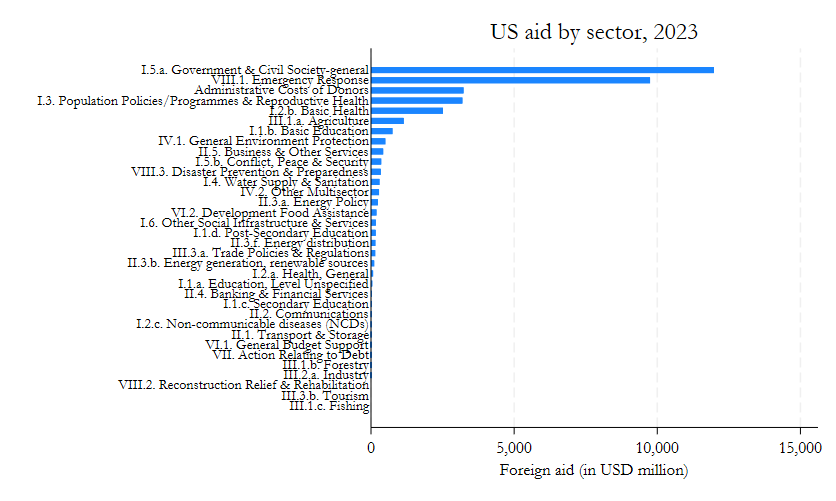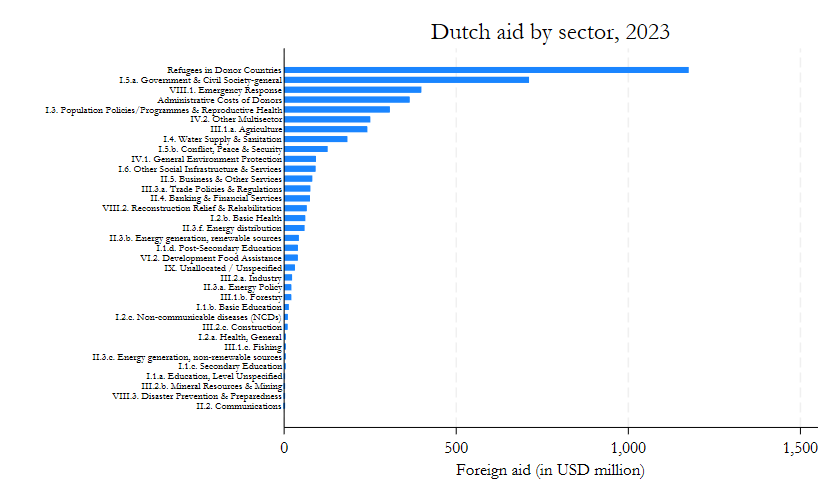The Future of Global Aid: Understanding USAID's Suspension and Its Global Impact
| Date: | 06 February 2025 |

The Trump administration's plan to merge the United States Agency for International Development (USAID) with the State Department—effectively suspending much of its operations—has sent shockwaves through the international development community in the past days. To grasp the implications of this move, it is crucial to understand USAID’s unique role in global development and how it compares to other donors, such as the Netherlands. Associate Professor Anna Minasyan, who is an expert in foreign aid allocation and effectiveness, sketches this role and gives insight into the potential consequences of USAID’s suspension.
USAID’s Dominant Role in Global Aid
Figure 1 illustrates aid disbursements (in USD millions) by U.S. and Dutch agencies based on recent data available from OECD’s Creditor Reporting System Database. U.S. agencies are represented in black, while Dutch agencies are shown in orange. Unlike the Netherlands, which channels all its foreign aid through the Ministry of Foreign Affairs, without a separate development agency, the U.S. aid system is highly complex, involving multiple agencies, with USAID at the forefront.

Note: Data is sourced from the Creditor Reporting System Database (2023) provided by the Organization for Economic Cooperation and Development (OECD). Agencies in orange represent the Netherlands, while those in black represent U.S. development cooperation agencies.
USAID, whose operations are now suspended, has historically played a central role in U.S. foreign assistance, distributing approximately $40 billion in aid in 2023—more than any other U.S. entity. The agency significantly outpaces both the State Department and the Department of Health and Human Services in aid disbursement. Although USAID enjoys a degree of operational autonomy, it is ultimately funded by Congress, with its administrator appointed by the U.S. president and confirmed by the Senate.
With over $55 billion in foreign aid in 2023, the U.S. remains the world’s largest official donor, with USAID serving as the most significant development agency globally. In contrast, Dutch aid in the same year was roughly one-tenth of the U.S. total and only a fraction of USAID’s. More than 99% of Dutch aid is distributed through its Ministry of Foreign Affairs.
Which sectors does aid fund?
Figure 2 breaks down USAID’s operations by sector. In 2023, the agency allocated the majority of its funding to Government and Civil Society, followed by Emergency Response. These two sectors make up the bulk of USAID’s funding, with Administrative Costs of Donors coming in third. Administrative costs are notable, as they indicate that roughly 10 percent of aid does not directly reach recipients. Other sectors benefiting from U.S. aid include health and population, agriculture, and education.

Note: Data is sourced from the Creditor Reporting System Database (2023) provided by the Organization for Economic Cooperation and Development (OECD).
Figure 3 presents the sectoral allocation of Dutch aid in 2023, which shows that the Netherlands spent most of its foreign aid on refugees within its own country. This was followed by funding for Governance and Civil Society and Emergency Response programs in recipient countries. Using foreign aid to finance refugee programs in donor countries is common across EU donors, many of which adopted this approach after the refugee crisis in 2015. Similarly to the U.S., the Netherlands also allocates a significant portion of its aid to Administrative Costs of Donors, which ranks in the top four sectors.

Note: Data is sourced from the Creditor Reporting System Database (2023) provided by the Organization for Economic Cooperation and Development (OECD).
Potential Consequences of the USAID Suspension
The proposed suspension and restructuring of USAID could have profound global consequences:
First, a humanitarian response gap may emerge. USAID’s emergency response capabilities, including famine early warning systems and crisis response mechanisms, are unparalleled. Few organizations can replicate these efforts at scale.
Second, health security risks could rise. As a major funder of global health initiatives—such as pandemic prevention and polio eradication—USAID’s disruption could lead to severe public health consequences.
Third, governance and stability challenges may arise. USAID’s substantial investment in governance and civil society programs promotes stability in fragile regions. Reducing these efforts could undermine global security interests.
Fourth, a loss of development expertise is likely. Merging USAID with the State Department risks diluting its technical expertise and shifting development priorities toward short-term foreign policy goals. A similar concern arose during the UK’s merger of DFID with the Foreign Office.
If the merger proceeds, the U.S. aid system will resemble that of the Netherlands, where foreign policy and development priorities are deeply intertwined due to the absence of a separate development agency. While this structure works for smaller donors, it may not be suited to a donor of the U.S.’s scale.
The Bigger Picture
The suspension of USAID is not occurring in a vacuum. For years, scholars have debated the macroeconomic impact of foreign aid, often finding little effect on overall economic growth. However, recent research highlights positive impacts in sector-specific areas like education, health, and women’s rights—many of which rely heavily on international development cooperation. Evidence also shows that U.S. aid is already political, often aligning with U.S. foreign policy interests. By dismantling or politicizing these programs through integration with the State Department, the existing effectiveness of aid at both the meso- and micro-levels could diminish.
Looking Ahead
The proposed changes to USAID represent more than just an administrative restructuring; they could fundamentally reshape the world’s largest bilateral aid program. Given USAID’s vast budget and comprehensive programming, its suspension will create gaps that even single European donors, such as the Netherlands, will struggle to fill. This situation calls for a stronger role for holistic EU aid through EU institutions. However, given recent political developments within the EU, the prospects for this approach remain uncertain.
Thus, the development community now faces a critical period of uncertainty. While some (emergency aid) functions may continue under State Department oversight, these changes could alter how the U.S. delivers aid and engages in international development for years to come.
More information
Anna Minasyan is an Associate Professor at FEB's Department of Global Economics and Management, with a research focus on the political economy of development and expertise in foreign aid allocation and effectiveness.
Research by Anna Minasyan
-
Minasyan, A., & Montinola, G. (2023). Gendered aid and women’s rights. SSRN Electronic Journal. https://doi.org/10.2139/ssrn.4433969
-
Minasyan, A. (2018). US aid, US educated leaders and economic ideology. European Journal of Political Economy, 55, 244–257. https://doi.org/10.1016/j.ejpoleco.2018.01.001
-
Minasyan, A., Nunnenkamp, P., & Richert, K. (2017). Does aid effectiveness depend on the quality of donors? World Development, 100, 16–30. https://doi.org/10.1016/j.worlddev.2017.07.023
-
Minasyan, A. (2015). Your development or mine? Effects of donor–recipient cultural differences on the aid-growth nexus. Journal of Comparative Economics, 44(2), 309–325. https://doi.org/10.1016/j.jce.2015.07.002
-
Minasyan, A., & Nunnenkamp, P. (2016). Remittances and the effectiveness of foreign aid. Review of Development Economics, 20(3), 681–701. https://doi.org/10.1111/rode.12193
-
Dreher, A., Minasyan, A., & Nunnenkamp, P. (2015). Government ideology in donor and recipient countries: Does ideological proximity matter for the effectiveness of aid? European Economic Review, 79, 80–92. https://doi.org/10.1016/j.euroecorev.2015.07.004

